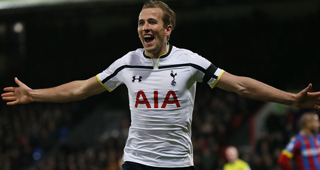Harry Kane keeps scoring goals and keeps getting new contracts and is the new viable hope for Tottenham and even for England.
Kane signed an extension in August to earn £20,000 per week through 2019 and now he’s been bumped up to £35,000 per week through 2020.
With his brace against Arsenal and a goal at Anfield, Kane figures to keep getting paid as Tottenham looks to get back to the Champions League for the first time since 10-11.
Whenever Tottenham has a player that draws interest from the likes of Real Madrid, the principal concern is whether it is financially viable to keep him. Unlike Gareth Bale, Luka Modric and Michael Carrick, Kane came up with Spurs following that brief dalliance with Arsenal at the age of eight and he has the chance to become a club icon the way Steven Gerrard has at Liverpool. Kane appears to sincerely value that type of career trajectory, even if it means perpetually clawing for a top-4 spot and more often than not grinding it out in the Europa League due to the depth of rich clubs in the Premier League.
Tottenham’s starting XI against Arsenal had the youngest average age (23.6) in the EPL this season and that certainly helps in playing at the pace Mauricio Pochettino demands as they press their opponents into submission and pave the way for late match winners.
Kane’s ascent started quietly but emphatically last April under Tim Sherwood, but fulfilling his promise was far from certain coming off his loans to Leyton Orient, Millwall, Norwich City and Leicester City. Kane didn’t even become a starter for Tottenham until November after it finally became clear he was the far superior option than Roberto Soldado and Emmanuel Adebayor. Playing Kane over players who were previously making three times and five times as much is a sunk cost decision no club enters into lightly. Not only is Tottenham continuing to pay Soldado and Adebayor after being unable to unload them in January, they have to keep upping Kane’s pay.
While several years younger than Diego Costa, Kane is a late bloomer in becoming this good at a relatively late age. Kane has yet to be capped by England, technically making him a free agent for international football the way Costa decided to play for Spain just a few months before last year’s World Cup.
You’re never sure if big, physical strikers like Kane, Costa and Romelu Lukaku are going to make it. Even if they do, there’s still a chance they simply become Andy Carroll. Kane has shown glimpses of being a very good player, but nobody realistically thought he was capable of this level of transcendence.
England ultimately needs Kane as much as Tottenham does and he can become their version of Thomas Müller.
Kane’s intelligent and energetic runs are exceptional in outplaying his talent just like Müller. Kane is outperforming Costa in Expected Goals + Assists per 90 minutes and is just slightly off the production of Luis Suárez’s final seasons at Liverpool.
Kane is a high volume shot taker, but he also converts at an outstanding rate and often late in matches. The Arsenal match winner over the weekend came in the 86th minute after he gave a gesture to Nabil Bentaleb to send it in to him, converting with the calm and confidence of someone who has been doing this on a regular basis for more than just three months.
One major improvement this season is how he has been a far more effective dribbler, which makes him far more dangerous and multi-dimensional than if he were simply a target man. Kane’s heatmap has a large radius from sideline to sideline and with a handful of goals from outside the area. Slowing down Kane requires the type of organized effort that usually is only necessary for Golden Ball winners.
Kane will also win the ball back on a tackle nearly twice as often as Costa and three times more often than Sergio Agüero. Suárez would similarly track back aggressively for Liverpool and having your best talent play at the highest work rate is remarkably infectious.
Beyond the physical maturation, part of the reason why Kane was a little slow to develop was because he was so well-rounded without a single attribute he was doing at a particularly high level to justify his place on the pitch. That’s of course changed as Tottenham figures to build their entire roster around him for the foreseeable future.
Tottenham has long been capable of far more than their results. They’ve been remarkably consistent over the past five seasons, finishing fourth twice, fifth twice and sixth this past season after selling Bale. Their new 56,000-seat stadium will debut in the summer of 2017 and they’ll continue to climb the ranks of the richest clubs in the world thanks to the EPL’s new television deal.
If the Spurs stay the course with Pochettino and Kane, there’s a formula there of prolonged success with young, hardworking players that differs dramatically from what Chelsea, Manchester City and Liverpool are doing and which Arsene Wenger has pragmatically abandoned as his tactics failed him for too many seasons.
Pochettino is a Marcelo Bielsa disciple and has clearly been strongly influenced by what Diego Simeone has done at Atlético Madrid, which is one of the most remarkable genius runs we’ve ever seen. Simeone has plugged and played Radamel Falcao, Costa, Mario Mandžukić and now even Fernando Torres at striker. The system and supporting cast is that strong, while Pochettino is reliant on Kane at this point.
A player as good and exciting as Kane, in England no less, is going to spark a thousand nicknames, from White Hart Kane to Citizen Kane and Prince Harry Kane. Hopefully his play during this Kanesanity phase is sustainable at even 80 percent because Spurs and England are two sleeping giants that make soccer far more interesting when relevant.



